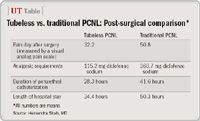Article
Tubeless PCNL lessens post-op pain, hospital stay
A 2-year study from India has found that tubeless percutaneous nephrolithotomy (PCNL) provides marginally better stone clearance than does traditional PCNL, with fewer complications.

Key Points

"Patients in our tubeless PCNL group were significantly less subject to pain when compared to standard care," Hemendra Shah, MD, chief urologist at the R.G. Stone Urological Research Institute in Mumbai, told attendees at the AUA annual meeting. "They needed less pain medication and were able to be discharged sooner than patients who received conventional treatment."
Dr. Shah and his colleagues examined all 168 patients who underwent tubeless PCNL using supracostal access at the Institute between September 2004 and August 2006. These patients' outcomes were compared with those of a historical control group that included 168 similar patients who underwent conventional PCNL with routine placement of a nephrostomy tube. There were no statistically significant demographic differences between the two groups.

Initial stone clearance was slightly better in the tubeless group than in the conventional treatment group (91.7% vs. 90.5%), Dr. Shah reported. In both groups, 95.2% of patients were stone free 2 months after surgery.
Complication rates between the two groups also were similar. Major complications occurred in 7.7% of the tubeless group compared to 8.9% of the conventional treatment group. The most common major complication was the need for blood. There were minor complications in 12.5% of patients in the tubeless group and 15.5% of patients in the conventional treatment group, most commonly a minor fever.
Less pain, lower analgesic use
Surgery-related outcomes for the study group were significantly better than for the control group, Dr. Shah said. Patients in the study group reported much less postoperative pain. The decrease in pain translated into lower analgesic use.
On a visual analog pain scale, tubeless patients reported a mean pain score of 53.7 on the day of surgery, compared to 76.2 among patients in the control group (p=.00). By the day following surgery, pain scores fell to a mean of 32.2 for the tubeless group and 50.8 for the conventional treatment group, a difference of 47.1% (p=.00).
Not surprisingly, postoperative analgesic requirements were 59.4% lower in the tubeless group, with a mean of 115.2 mg of diclofenac sodium (Arthrotec, Solaraze, Voltaren) compared to 360.7 mg for patients in the control group, Dr. Shah said.
Other outcomes were equally positive. The need for perurethral catheterization was 32.8% (p=.00) lower in the tubeless group than in the conventional group (mean of 28.3 hours vs. 41.6 hours). Mean length of stay was 35% shorter for the tubeless group (34.4 hours in the hospital following surgery vs. 50.3 hours for the conventional treatment group, p=.00).





